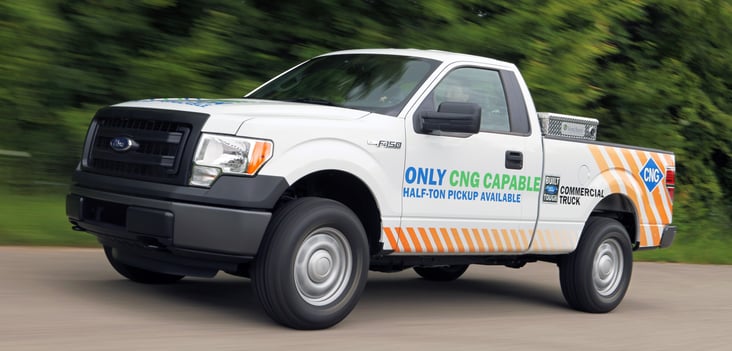This post is one in a series featuring the complete slate of advanced energy technologies outlined in the report This Is Advanced Energy.

Natural gas vehicles (NGVs) are internal combustion engine vehicles designed to run on either Compressed Natural Gas (CNG) or Liquefied Natural Gas (LNG). There are three basic categories of NGVs: dedicated, bi-fuel, and dual-fuel. Dedicated NGVs are the most efficient as they are designed from the ground up to run only on natural gas. In contrast, both bi-fuel and dual-fuel NGVs have two separate tanks, one for natural gas and another for diesel or gasoline. Bi-fuel NGVs can run on either natural gas or a petroleum fuel (either diesel or gasoline), switching automatically when one fuel runs out. Bi-fuel technology is typically used in light-duty vehicles. Dual-fuel NGVs run on a mixture of natural gas and diesel. They rely mostly on natural gas, but use a small amount of diesel to aid in fuel ignition. Dual-fuel NGVs are more expensive, but their higher efficiency makes them an attractive option for heavy-duty vehicles. Most NGVs rely on less-expensive CNG, but some vehicles used for long-haul trucking run on LNG because its higher energy density increases driving range.
There are an estimated 150,000 NGVs in use in the United States today. Because both CNG and LNG vehicles rely on dedicated fueling infrastructure, NGV technology is most commonly used for vehicles operating within a limited geographic area (transit buses, taxis and delivery vehicles) or along predictable routes (long-haul trucks). Several U.S. cities have introduced CNG transit bus eets, including Phoenix, Los Angeles, Fort Worth, Dallas, and Atlanta. Now that natural gas prices have fallen, several vehicle manufacturers, including Honda, Ford, General Motors, and Chrysler, are also beginning to offer NGV versions of popular light-duty models. In addition to fueling on-road vehicles, natural gas can also power rail and marine vehicles. General Electric (GE) offers a natural gas retro t kit that enables locomotives to run on both diesel and LNG using dual-fuel technology.
While NGVs are more expensive than equivalent gasoline or diesel vehicles, they can deliver signi cant lifetime savings due to lower fuel costs; for example, GE’s LNG dual-fuel locomotives can reduce fuel costs by 50%. Especially for heavy-duty vehicles with high annual mileage, even a relatively small fuel price differential adds up, resulting in payback periods as short as 12 to 15 months and significant savings over the life of a vehicle. The Dallas Area Rapid Transit (DART) system expects to save $120 million in fuel costs over 10 years by switching to CNG buses fueled by locally sourced natural gas. In addition, both new and retro tted NGVs provide consumers and businesses with alternative fuel options. In particular, bi-fuel NGVs allow operators to switch between fuels according to price, fuel availability, and other criteria. On a national scale, the adoption of NGVs also increases fuel diversity, boosts energy security, and delivers cost savings.
Learn more about natural gas and other advanced energy fuels and technologies in This Is Advanced Energy, a free report available below:
